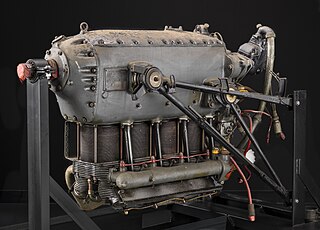
The Hitachi Hatsukaze, also known as the Hitachi GK4, Hitachi Army Type 4 110hp Air Cooled Inline, Hitachi Ha47 and Ha-11 model 11 (unified), was Hitachi's fourth design in a series of aircraft engines built in Japan prior to and during World War II. The original Hatsukaze was a license-built Hirth HM 504. Hatsukaze engines were air-cooled, four-cylinder, inverted inline engines developing around 82 kW (110 hp).

The Nakajima Ki-115 Tsurugi is a one-man kamikaze aircraft that was developed by the Imperial Japanese Army Air Force during the closing stages of World War II in 1945. The Imperial Japanese Navy called this aircraft Tōka.

The Nakajima Ki-43 Hayabusa, formal Japanese designation Army Type 1 Fighter is a single-engine land-based tactical fighter used by the Imperial Japanese Army Air Service in World War II.

The Mitsubishi Ki-67Hiryū was a twin-engine bomber produced by Mitsubishi Aircraft Company and used by the Imperial Japanese Army Air Service and Imperial Japanese Navy Air Service in World War II. While its original official designation was "Army Type 4 Heavy Bomber", in all of its key parameters, the Ki-67 was similar to the contemporaneous medium bombers of other countries. Japanese Navy variants included the P2M and Q2M.

The Kyūshū Q1WTōkai was a land-based, anti-submarine patrol bomber aircraft developed for the Imperial Japanese Navy in World War II. The Allied reporting name was Lorna. Although similar in appearance to the German Junkers Ju 88 medium bomber, the Q1W was a much smaller aircraft with significantly different design details.
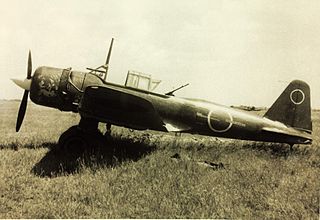
The Mitsubishi Ki-51 was a light bomber/dive bomber in service with the Imperial Japanese Army during World War II. It first flew in mid-1939. Initially deployed against Chinese forces, it proved to be too slow to hold up against the fighter aircraft of the other Allied powers. However, it performed a useful ground-attack role in the China-Burma-India theater, notably from airfields too rough for many other aircraft. As the War drew to a close, the Japanese began using them in kamikaze attacks. Total production was around 2,385.
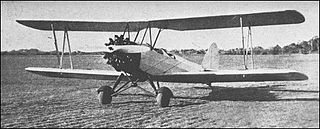
The Tachikawa Ki-17 was a basic training aircraft of the Imperial Japanese Army Air Force built by Tachikawa Aircraft Company Ltd in the 1930s. It was known to the Allies under the nickname of Cedar during World War II.

The Tachikawa Ki-9 was an intermediate training aircraft of the Imperial Japanese Army Air Force built by Tachikawa Aircraft Company Ltd in the 1930s. It was known to the Allies under the nickname of "Spruce" during World War II. This aircraft was mistakenly identified as a Tatchikawa by the British.

The Tachikawa Ki-94 was a single-seat fighter-interceptor aircraft project undertaken by the Tachikawa Aircraft Company and to be operated by the Imperial Japanese Army. The project refers to two aircraft designs: the Ki-94-I and the Ki-94-II, both of which did not advance beyond the mock-up and prototype stage respectively.
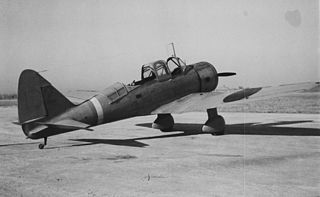
The Tachikawa Ki-36 was a Japanese army co-operation aircraft of World War II. It was a two-seat, low-wing monoplane with a single piston engine and fixed, tailwheel-type undercarriage.

The Tachikawa Ki-55 was a Japanese advanced trainer.
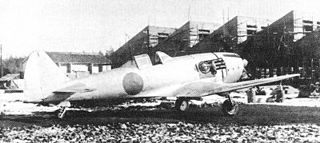
The Nakajima Ki-87 was a Japanese prototype, high-altitude fighter-interceptor of World War II. It was a single seat, exhaust-driven turbo-supercharged engined, low-wing monoplane with a conventional undercarriage.

The Nakajima Ki-49Donryu was a twin-engine Japanese World War II heavy bomber. It was designed to carry out daylight bombing missions, without the protection of escort fighters. Consequently, while its official designation, Army Type 100 Heavy Bomber, was accurate in regard to its formidable defensive armament and armor, these features restricted the Ki-49 to payloads comparable to those of lighter medium bombers – the initial production variant could carry only 1,000 kg (2,200 lb) of bombs.

The Mitsubishi Ki-30 was a Japanese light bomber of World War II. It was a single-engine, mid-wing, cantilever monoplane of stressed-skin construction with a fixed tailwheel undercarriage and a long transparent cockpit canopy. The type had significance in being the first Japanese aircraft to be powered by a modern two-row radial engine. During the war, it was known by the Allies by the name Ann. It was mistakenly identified by the British as the Mitsubishi Army 97 Ann.

The Kokusai Ki-76, or Liaison Aircraft Type 3, was a Japanese, high-wing monoplane artillery spotter and liaison aircraft that served in World War II. The Allied reporting name was Stella.

The Kokusai Ki-59 was an early 1940s light transport monoplane built by Nippon Kokusai Koku Kogyo K.K for the Imperial Japanese Army as a development of the Teradako-ken TK-3, which had first flown in 1938.

The Rikugun Ki-93 was a prototype, Japanese, twin-engined fighter aircraft of the Second World War. Designed by the Army Aerotechnical Research Institute to be a heavy fighter armed with large calibre cannon to serve in the anti-shipping or bomber destroyer roles, only one example of the Ki-93 was completed; this was damaged on its maiden flight and destroyed by American bombing before it could be flown again.
The Tokyo Koku Ki-107 was a Japanese military training aircraft for the Imperial Japanese Army Air Force. The Ki-107 was a wooden-built, low-wing, two-seat monoplane with an open cockpit. Powered by a Hitachi Hatsukaze Ha-47 (Ha-11) inline piston engine, it first flew in October 1943. The Japanese Army had ordered 450, as primary trainers, as replacement for the Kokusai Ki-86, but production was held up by air raids and only twenty-nine had been delivered by the end of the War.
The Mansyū Ki-98,, was a Japanese ground-attack aircraft proposed by Mansyū during World War II for use by the Imperial Japanese Army Air Force. The still unassembled components of the first prototype were deliberately destroyed before Japan surrendered.

The Tachikawa Ki-92 was an experimental Japanese heavy transport aircraft of World War II. It was a low-wing monoplane with a pressurized fuselage, twin piston engines and a tailwheel undercarriage.


















